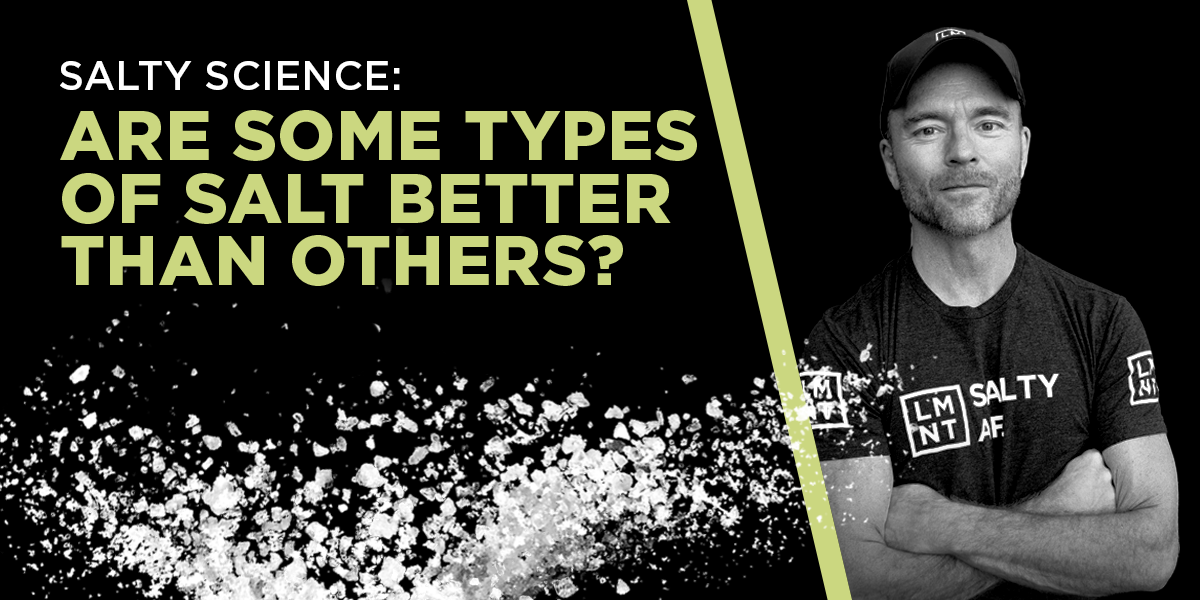Inevitably, when you consume products like table salt, kosher salt, sea salt, and Himalayan pink salt, you aren’t just getting sodium and chloride.
For instance, most table salts and sea salts contain trace amounts of microplastics: tiny particles of polypropylene, polyethylene, nylon, and other synthetic materials. The effects of ingesting microplastics aren’t clear, but in mouse models these particles have been found in their livers, kidneys, and guts. I understand that may sound quite frightening, but allow me to provide a reference point: the amount of microplastics taken in through inhalation, especially of indoor air, is typically much greater (~428 times greater) than that of table salt.
Often, the next concerns I hear from people are the heavy metals—such as aluminum, lead, and cadmium—that accompany table salt and pink salt. The reality of the matter is that it’s practically impossible to avoid heavy metals in food that come from natural sources. They’re found in wine, nuts, cauliflower, and even spinach. But thankfully, under ordinary circumstances our bodies are capable of expelling the tiny amounts of heavy metals found in ancestral foods.
To be clear, just about everything we consume has some level of contamination. That’s simply the world we live in. So unless you plan on trading in your fresh air for scuba gear, or your ancestral whole foods for sterile lab-grown food, I wouldn’t attempt to stop consuming salt. Electrolytes are vital to our existence.
Still, of course, microplastics are not meant for human consumption. And great quantities of all heavy metals (even the essential ones like iron) eventually become toxic. The key is to avoid significant quantities of these impurities, not to shun healthy foods and fresh air.
In the case of salt, among other foods, that means buying from companies that you trust. Reach out to them directly if you have questions and if they respond openly and transparently, I think that’s a good sign to start.
Let’s get started. Today we’ll cover microplastics, heavy metals, and some FAQs about LMNT, our tasty electrolyte drink mix. But first, I’d like to talk about sodium and the reasons why many people aren’t getting enough.
What Is Salt?
Salt, as most people know it, is actually a molecule named Sodium Chloride. This is denoted by its chemical formula: NaCl. The “Na” stands for sodium and the “Cl” for chloride.
And these two minerals—sodium and chloride—almost always appear together in nature.
Sodium and chloride are both electrolytes, charged elements that conduct electricity to power your nervous system and balance fluids in your body. Both are essential for living and thriving.
That’s why animals evolved a predilection for salt. Something that tasted salty (like blood) would provide these precious minerals.
This predilection is strong. When rats are deprived of salt, they loaf around and lose interest in normal activities. They become depressed.
Throughout human history, salt has traditionally been used for two main purposes:
- To provide flavor
- As a preservative
Only recently has a third purpose emerged: salt as an essential nutrient. (It’s always been essential, but only lately have we started publishing science on it). By deliberately consuming more salt, we can enhance our wellbeing.
But this isn’t the mainstream view.
Why Sodium Isn’t Bad for You
The mainstream view is that salt should be zealously limited. The US government, for instance, recommends capping sodium intake at 2.3 grams per day, which is around 1 teaspoon of salt.
But the data behind this recommendation is weak. It’s mostly based on research that found that salt-sensitive rats develop high blood pressure when pumped full of sodium.
The full body of human data tells a different story. It says that:
- Around 4–6 grams of sodium (2–3 teaspoons of salt) per day is the sweet spot for heart health.
- Sodium restriction in line with government guidelines is linked to higher blood pressure.
- Sweaty athletes lose up to 7 grams of sodium per day. (It needs to be replaced!).
- Sodium deficiency causes symptoms like headache, fatigue, confusion, and weakness.
There’s a lot more to say about sodium, but I need to move on. Check out this article to go deeper down this salt mine.
The practical takeaway is that most people don’t get enough salt. As a result, they don’t feel or perform their best.
But we shouldn’t reach for any old salt. Most salt contains contaminants, and the worst offender may be table salt.
The Problems With Table Salt
Table salt is the most common type of commercial salt. It can come from sea or land sources, but the defining feature is that it’s refined.
The refining process typically involves chemicals like chlorine and sulfuric acid that turn the salt white. Trace amounts of these chemicals likely remain in the finished product.
Table salt is also fortified with iodine, an essential mineral lacking in the modern diet. Iodine sufficiency can help prevent a variety of health disorders, including childhood learning disabilities.
Iodine is also necessary for producing thyroid hormones. This can be a good thing, but not always. Calibrating iodine intake based on salt intake can make managing thyroid disorders a challenge, especially when those disorders require medication. Because we realize not everyone will benefit from iodized salt, we don’t put any iodine or iodized salt in our products.
While iodine is a (largely) positive addition to table salt, other compounds are not. Table salt is around 97-99% sodium chloride. What’s the other 3 percent? Mostly, anti-caking agents.
Anti-caking agents are chemicals used to prevent salt from clumping due to its natural moisture content. The problem is, many of these chemicals contain harmful heavy metals and other toxins.
Two commonly used anti-caking agents are sodium aluminosilicate and calcium aluminosilicate. Both of these compounds contain aluminum, a widely known neurotoxin that may contribute to the pathogenesis of Alzheimer’s disease. But since the precise mechanism of Alzheimer’s pathogenesis is still unknown, this issue is controversial.
Sodium ferrocyanide decahydrate, commonly known as “yellow prussiate of soda” (YPS), is another anti-caking agent. It’s safe for human consumption and does not accumulate in the body, which is why we choose it as the anti-caking agent for our salt.
What about kosher salt? Kosher salt is just table salt with a larger grain size. It’s not safer, healthier, or less refined.
Table salt comes from sea or land sources and then is refined. So why not just get our salt straight from the sea?
The Problems With Sea Salt
The problems with sea salt can be summarized in a single word: microplastics.
Microplastics are tiny particles of plastic sized between 1 and 100 nanometers. These particles—which now contaminate the air, water, and salt—are the product of decades of irresponsible plastic manufacturing and disposal.
The world’s oceans now teem with these particles and fibers. The highest concentrations appear to be in Asian waters, but evidence for microplastics has been found in nearly every region that researchers have analyzed.
Even allegedly clean waters (like the Celtic Sea) have been found to contain microplastics. If it’s an ocean, it probably has plastic in it.
And these microplastics, it’s been shown, end up in our table salt and sea salt.
In one 2018 study, researchers found microplastics in 25 different brands of sea salt from all over the world. They determined that the level of plastic in the salt was a good indicator of the level of plastic in the water.
Should you be worried about consuming microplastics? Although occupational data has linked inhaling it to respiratory issues, there’s no human evidence that ingesting it is dangerous.
But there is animal evidence. In animal models, ingested microplastics have reached multiple organ systems, including crossing the blood-brain barrier, placenta, and cell membranes.
That’s not comforting. I think it’s smart to play it safe and minimize exposure to microplastics.
And that means looking to land sources of salt. How about that pink stuff?
The Problems With Himalayan Salt
Himalayan pink salt comes from salt mines in the Punjab region of Pakistan, an area bordered by the Himalayan mountain range. Pink salt is mined from other regions too, but most of it comes from Pakistan.
Himalayan salt is technically sea salt, but it’s not modern sea salt. It’s sea salt from hundreds of millions of years ago when the region was underwater.
That means microplastics are of little concern. So that’s a plus.
Himalayan salt is popular these days because it contains a range of minerals: potassium, calcium, iron, copper, molybdenum, iodine, zinc, cobalt, manganese, and many others. It’s marketed as a trace mineral complex.
But to get meaningful amounts of these minerals, researchers estimate you’d have to consume about 6 teaspoons of pink salt per day. That’s about double what I recommend as a baseline, and I’m all about staying salty.
The real concern with Himalayan salt, however, is the potential for heavy metal exposure beyond standard allowable amounts in naturally occuring minerals. A recent Australian study found heavy metals like aluminum, cadmium, and lead in 31 commercial pink salts. One product—a pink salt from Peru—contained enough lead to exceed the maximum contaminant level set by the Australian government.
Picking a Healthy Salt
All salt has plenty of sodium chloride, but it’s important to also pay attention to how your salt is sourced. Mining and quality testing procedures affect the end result that you’re putting into your body.
That’s why we use traditionally-mined salt from non-blast operations in LMNT and test it for allowable and safe levels of heavy metals at every point in the production process. This way, we ensure that impurities are minimized and our ability to Stay Salty is maximized.

